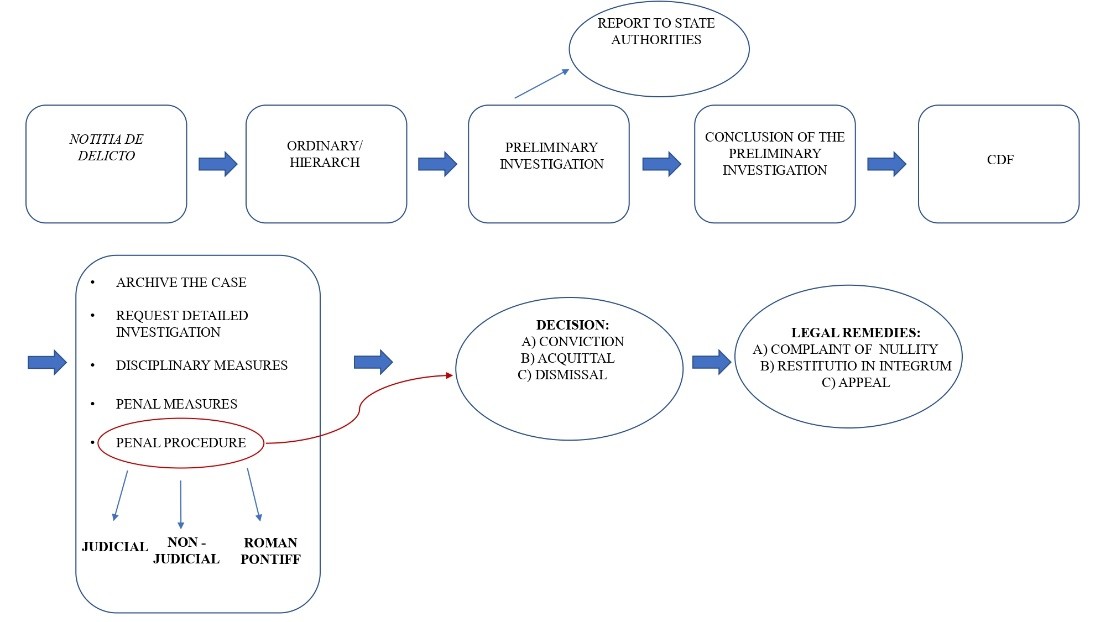Dealing with sexual abuse of minors within the Catholic Church
Written by: Assoc. Prof. Dr. Anna-Maria Getoš Kalac & Petra Šprem
A major leap in recognizing sexual abuse of minors by clergy as a systemic problem, instead of referring to them as simple isolated incidents, was made by a team of investigative journalists in Boston. In 2002 the Boston Globe published a story about systemic cover-ups of minor abuse in the Catholic Church in America. Sexual abuse scandals, in which many American cardinals and bishops found themselves involved, led to the most severe crisis of the Catholic Church and a serious loss of trust of believers in the Church (Boston Globe Investigative Staff, 2002).

The cover of the Boston Sunday Globe, which exposed the Church’s silence on abuse among its members (you can read the original articles of the magazine here). [Image source]
Shortly after articles from the Boston journalists, in 2004 and 2006, John Jay College published a detailed study on the sexual abuse of minors by the Catholic clergy [Available here]. U.S. research has marked the beginning of a global uncovering of cases of abuse in the Catholic Church. Thus, in 2009, a Murphy and Ryan report for Dublin was published in Ireland, showing that 46 reported priests had sexually abused over 100 young people over a period of approx. 30 years (1975-2004) [Available here]. A study commissioned by the German Bishops’ Conference found that in Germany 1,670 clergy members sexually abused as many as 3,677 minors, mostly male children, between 1946 and 2014 [Available here]. The study’s authors reviewed more than 38,000 documents from 27 dioceses and found that over half of the victims were 13 or younger.
In addition to the increased public interest, scholarly inquiry into clergy sexual abuse has grown considerably since the late twentieth century (Guerzoni & Graham, 2015) .
Church enlightens on cases of abuse
When scandals of abuse within the Church took on global proportions, which was among other things also a result of the 2015 blockbuster movie ‘Spotlight’ , the Church realised that it had to face the accusations, clean up its ranks and work towards improving its image in order to retain its societal position and influence. Of course, in order to do so, the first step was to answer the greatest question – why was minor abuse happening? Unfortunately, up until today not much relevant comprehensive criminological research has been conducted on the causes of clergy abuse of children.
The earlier mentioned research by John Jay College, at least stopped an etiological polarization within the public discourse – whether celibacy ‘makes’ priests turn into sexual predators or whether sexual predators more frequently enter the Catholic Church’s clergy. Research has shown that the number of cases of paedophilia or ephebophilia is no higher than in some other occupations. For example, the survey states that, in general, an overall percentage of child and youth sexual male abusers in the world is around 8%, 5% among teachers, and about 4% among active clergy. Additionally, sexual abuse is always associated with power abuse (Reynaert, 2015). It is worth mentioning that research show that all organisations involving children and young adolescents (i.e. in which adult men come into close, superior contact with children and young people) show a larger number of registered cases of paedophilia than within some other organisations (like, for example, in scouting agencies (Boyle, 1994)).
Whatever etiological factor is taken into account, the fact remains that sexual abuse occurs. Society, which includes the Catholic Church, has a responsibility to begin to deal with these cases much more vigurously. In February 2019, an extremely important four-day conference called “Protection of Minors in the Church” was held, where two hundred cardinals and presidents of episcopal conferences from all over the world discussed cases of abuse and how to prevent abuse from happening. The same conference heard testimonies of actual abuse victims. This was was a huge turning point in the way the Church has dealt with these cases so far. Thus, the Vatican took a much harsher approach at that point, stopping the long-term practice of moving priests accused of abuse from one parish to another. Instead, such priests were fired, demonstrating seriousness in the Church’s intention to condemn abusers and show compassion and support to the victims.
Vatican Handbook - Spreading the Catholic Vision
In July this year, the Vatican published the Vatican Handbook – a manual with instructions for investigating allegations of child abuse in the Catholic Church. This Handbook is intended to guide bishops and members of the clergy in dealing effectively with allegations of abuse conducted by its members. The Handbook refers to criminal offenses of clergy against the sixth commandment of the decalogue, which includes, amongst others, the sexual abuse of minors. A characteristic element of this criminal offense is the age of the victim (now under 18, formerly 16), regardless of whether the minor consented to the abuse or not (On April 30th, 2001, John Paul II published an apostolic letter regarding the Normae de gravioribus delictis Congregationi pro Doctrina Fidei reservatis in which the age of 16 for all the delicts of minor abuse was raised to 18 years).
The purpose of the Handbook is to implement the De gravioribus delictis norms (Articles 1-26). These deal with court proceedings in the canonical system (i.e. ecclesiastical court) and in no way interfere with charges and measures taken before civil courts (i.e. which act in accordance with their own laws). This means that whoever addresses the ecclesiastical court may also address the civil court by filing a lawsuit for similar criminal offenses. The conduct of the Church by no means seeks to exclude certain criminal offenses from the jurisdiction of civil courts or to cover them up. It is therefore possible to determine and impose criminal measures twice for a criminal offense committed against a person under the age of 18 – (i) criminal measures according to the norms of canon law and (ii) criminal measures according to the norms of criminal law of a particular state. Both measures are completely independent and autonomous and must not be confused with one another.
The Vatican Handbook consists of 164 articles which contain legal norms and best practices that bishops and members of the clergy must follow when they receive an accusation, or become aware of minor abuse by a member of the clergy.
It is important to point out that for a long time, the Catholic Church resisted removing the pontifical secret from abuse cases. On December 17th 2019, Pope Francis issued a new legislation regarding the pontifical secret in relation to “cases of sexual misconduct” thus abolishing the pontifical secret. That same document obliges all dioceses in the world to organize one or more permanent and publicly available systems for reporting sexual abuse committed by clerics and monks by the end of 2020. The decision on the form of these systems is left to the diocese.
The Vatican Handbook document is intended primarily for Ordinaries in governing cases of sexual abuse against minors committed by clerics. The delict in question includes every external offense against the sixth commandment of the Decalogue (“Thou Shalt Not Commit Adultery”) committed by a cleric against a minor (i.e. up to 18 years old). The typology of the delict is quite broad; it can include, for example, sexual relations (consensual or non-consensual), physical contact for sexual gratification, exhibitionism, masturbation, the production of pornography, inducement to prostitution, conversations and/or propositions of a sexual nature, which can also occur through various means of communication. The information about a possible delict (notitia de delicto) does not have to be formal, but it has to contain information regarding a possible assault. Even when the information comes from sources whose credibility might appear doubtful at first, it should not be dismissed a priori. Instead, information regarding a possible assault should be appropriately assessed and, if reasonably possible, given all due attention. When a notitia de delicto is received, a preliminary investigation shall be undertaken. Even in cases where there is no explicit legal obligation to do so, the ecclesiastical authorities should make a report to the competent civil authorities if this is considered necessary to protect the victim or other minors from the danger of further criminal harm. The task of undertaking an investigation belongs to the Ordinary or Hierarch of the accused cleric or, if different, the Ordinary or Hierarch of the place where the alleged delicts took place.
The preliminary canonical investigation must be carried out independently of any corresponding investigation by the civil authorities. In those cases, where state legislation prohibits investigations parallel to its own, the ecclesiastical authorities should refrain from initiating the preliminary investigation and report the accusation to the Congregation for the Doctrine of the Faith (further on: CDF), including any useful documentation. In cases where it seems appropriate to await the conclusion of civil investigations in order to acquire their results (or for other reasons) the Ordinary or Hierarch would do well to seek the advice of the CDF in this regard.
It is important to notice that the preliminary investigation is not a trial. It serves for gathering evidence which might be useful for a more detailed examination of the notitia de delicto as well as to determine the plausibility of the report.
Two principles apply in relation to the question whether the Ordinary or Hierarch is obliged to inform the civil authorities of the receipt of a notitia de delicto and the opening of a preliminary investigation – respect for the laws of the state and respect for the desire of the alleged victim, provided that this is not contrary to civil legislation. Alleged victims should be encouraged to exercise their duties and rights vis-à-vis the state authorities. When the laws of the state require the Ordinary or Hierarch to report a notitia de delicto, he must do so, even if it is expected that on the basis of state laws no action will be taken (for example, in cases where the statute of limitations has expired or the definition of the crime may vary). Whenever civil judicial authorities issue a legitimate executive order requiring the surrender of documents regarding cases, or order the judicial seizure of such documents, the Ordinary or Hierarch must cooperate with the civil authorities.
The Handbook emphasizes that it is absolutely necessary to avoid any act that could be interpreted by the alleged victim as an obstacle to the exercise of his or her civil rights vis-à-vis the civil authorities.
Interestingly, the Handbook also obliges the Ordinary or Hierarch to defend the good name of the persons involved and to protect the public good, as well as to avoid other factors (for example, the rise of scandal, to impose precautionary measures).
The preliminary investigation last as long as it takes to fulfill the purpose of the investigation. Once the preliminary investigation is concluded, whatever its outcome, the Ordinary or Hierarch is obliged to send, without delay, an authentic copy of the relative acts to the CDF together with its own evaluation of the results of the investigation and any suggestions it may have on how to proceed.
After attentively examining the acts, the CDF can then choose to act in a variety of ways: it can archive the case; request a more thorough preliminary investigation; impose non-penal disciplinary measures; impose penal remedies; initiate penal proceedings; or identify other means of pastoral response. According to canon law, three penal procedures are possible: a judicial penal process; an extrajudicial penal process; or a dismissal from the clerical state or deposition, together with dispensation from the law of celibacy. The latter will be done by the Roman Pontiff when it is manifestly evident that the delict was committed. The extrajudicial penal process is carried out in a slightly less formal way, while the judicial penal process is similar to state criminal proceedings.
The decision concluding penal proceedings might result in: a) conviction (“constat”) in which the decision must indicate specifically the type of canonical sanction imposed or declared, b) acquittal (“constat de non”) and c) dismissal. Legal remedies for the convicted cleric are: a complaint of nullity, restitutio in integrum, or appeal, and the only tribunal of second instance for appeals is the appeal Tribunal of the CDF.

Procedure scheme in cases of alleged clergy abuse
With this Handbook, the Vatican has undoubtedly made a big step forward in dealing with sexual violence against minors in its ranks. This document gives clear instructions to the clergy that cases of abuse are to be taken seriously and provides them with rules for handling such cases. The document forces the Ordinaries to cooperate more closely with civilian authorities and shows compassion to the victims and the need to protect them. Even though this represents a major step forward, there are certain parts of the Handbook which are still questionable. For example, in one paragraph the Handbook obliges the Ordinary or Hierarch to “avoid the raise of a scandal”, or in another part, in cases where there is no explicit legal obligation to do so, states the ecclesiastical authorities should make a report to the competent civil authorities “if this is considered necessary to protect the person involved or other minors from the danger of further criminal acts”.
Undoubtedly, the Catholic Church faces a long and challenging path on which it has to prove it has zero tolerance for violence and abuse, unlike in certain previous years, when it seemed to turn a blind eye on it, or even actively covering it up. The Vatican Handbook makes it possible to believe that the Catholic apologetics will finally come out of Plato’s cave; whether such a scenario will happen, remains to be seen.
Note: This year, everyone interested in this topic and investigative journalism has a unique opportunity to speak to one of the journalists from the Boston Globe team who revealed a major cover-up of sexual abuse in the Catholic Church in 2002. For his investigative work for the Boston Globe he received the Pulitzer Prize and the story was filmed in an Oscar winning movie “Spotlight”. His name is Michael Rezendes, and he will be one of lecturers of this year’s Balkan Criminology Courses in Dubrovnik. For more details about the Course, please see here.
References
Boyle, P. (1994). Scout’s Honor: Sexual Abuse in America’s Most Trusted Institution. Prima Lifestyles.
Comission of Investigation (2009). Report into the Catholic archdiocese of Dublin. Dublin. Available here.
German Bishops’ Conference (2018). Sexual abuse of minors by catholic priests, deacons and male members of orders in the domain of the German Bishops’ Conference. Available here.
Guerzoni, M.A. and Graham, H. (2015). Catholic Church Responses to Clergy-Child Sexual Abuse and Mandatory Reporting Exemptions in Victoria, Australia: A Discursive Critique. International Journal of Crime, Justice and Social Democracy (4)4, pp.58-75, p. 59.
IOANNES PAULUS II, Litt. Ap. Motu proprio datae quibus Normae de gravioribus delictis Corgregationi pro Doctrina Fidei reservatis promulgantur (30. IV. 2001.), u: Acta Apostolicae Sedis, 93 (2001) 11, 737-739; 785-788
Reynaert, M. (2015). Sexual abuse of children as a form of power abuse and abuse of the body. Acta theol. (35)1, Bloemfontein, p. 189-200.
The John Jay College Research Team (2004). The nature and scope of the problem of sexual abuse of minors by Catholic priests and deacons in the United States, 1950-2000. Washington & The John Jay College Research Team, 2006. The nature and scope of sexual abuse of minors by Catholic priests and deacons in the United States – Supplementary data analysis. Washington. Available here.
